The Long Weekend Trip - Day 3
The slow was slow and easy because of the wet slippery track and also we were savoring the beauty of the rain forest. There was part of the forest which reminds us our drive up to
After the 12km of unsealed track, the track is then connected to the
The view changed from forest into grassland with diary farm and beautiful green pasture and then back to forest at Fly Tree Top Walk.
The Otway Fly is a 600 metre long walk, 25 metre above the forest floor, made from 120 tonnes of steel. It was opened on Sept 8, 2003 and is privately owned located on 225 acres. The structure was prefabricated in Launceston and shipped over in 8 metre spans where it erected on site by the use of cranes. It took 10 months to complete the project. The structure can withstand winds up to 280km/h.
Entrance to the walk is about $14 per person. It was an easy walk and was also drizzling which give a magic touch to the walk. Along the way there are displays describing the forest and what to look for. We met a few people who were afraid of height and they want to get of the Fly Walk as quick as possible. I am afraid of height but I also enjoyed the walk and scenery.
We had lunch at Otway Fly Café. The hot foods were selling like hot cakes and there was a long queue for it. The café closes at 2.30pm.
After the walk we headed South West to The Twelve Apostles and Loch Ard gorge.
The mighty Twelve Apostles are world-recognised icons of the
The dramatic and imposing limestone cliffs that are the backdrop to the Apostles tower up to 70 metres, while the tallest of the rock stacks is around 45 metres high.
The Apostles had their beginnings up to 20 million years ago with the forces of nature attacking the soft limestone of the Port Campbell cliffs. The limestone was created through the build up of skeletons of marine creatures on the sea floor. As the sea retreated, the limestone was exposed. The relentless, stormy Southern Ocean and blasting winds gradually eroded the softer limestone, forming caves in the cliffs. The caves eventually became arches and when they collapsed, rock islands up to 45 metres high were left isolated from the shore.
This has created the Twelve Apostles and a host of other stunning natural features along this truly remarkable stretch of coastline. Among them are Pudding Basin Rock, Island Arch, the Razorback,
Extensive boardwalks and viewing platforms ensure visitors experience sweeping, awe-inspiring vistas. While anytime of day provides great views, sunrise and sunset are particularly impressive for the blazing hues created.

Loch Ard Gorge visitors are treated to a beautiful vista of towering cliffs, sparkling blue-green sea and a small, sandy beach. It’s hard to imagine that the drama of one of Victoria’s most tragic shipwrecks was played out at this very spot more than 120 years ago, giving a name to the gorge.
Fifty-two people died after the sailing ship, the iron clipper Loch Ard, rammed into the sheer cliffs of
According to Tom’s account of the disaster, the ship had been sailing in thick, hazy weather. When noticed it was rapidly heading toward shore, Captain Gibb began evasive action and dropped the anchors. But the ship dragged the anchors and desperate attempts to raise the sails were abruptly cut short when the Loch Ard struck the cliffs. “The ship commenced to roll, and was fast sinking, the sea breaking aboard her on both sides,” Tom said in his account. “Captain Gibb ordered the lifeboat to be got ready to receive the ladies. They could not get the boat clear of tackling for some time, owing to it being stuck on the skids.”
Tom said he and five seamen managed to launch the port lifeboat and hold it against the ship to receive passengers. But a huge wave struck and washed them away. Tom was eventually washed into the gorge.
“During the whole of these proceedings, the captain stood on the port side of the ship giving orders. The ship went down within 10 minutes or quarter of an hour after striking the bluff,” Tom said.
Eva was lucky to survive. Washed into the boiling sea with only a life-belt, she managed to grab hold of a floating chicken coop.
“By this time, the Loch Ard had disappeared under the waves,” Eva said in her statement. “In a few minutes, after turning the point of the rock, I saw Tom Pearce standing on the beach. I shouted to him, where upon he walked into the water and swam towards me.
“Tom had a desperate struggle to bring me ashore; and from the time I shouted to him to the time we were safe on the beach about an hour must have elapsed.”
Tom took Eva to the cave in the cliff behind the beach. They found a case of brandy and drank a bottle.
“Cold and exhausted - for we must have been in the water for about five hours - we lay down on the ground. I soon fell into a state of insensibility, and must have been unconscious for hours,” Eva said.
Tom climbed the precipitous cliffs and met a party from nearby Glenample homestead. Eva also was soon rescued and taken back to the homestead to recuperate.
Visitors to Loch Ard today can descend the staircase to the beach and see where Tom and Eva struggled to survive. They can visit the cave where the teenagers collapsed, exhausted. Visitors also can walk along the headlands and overlook the very spot where the Loch Ard smashed into the sheer cliffs. Storyboards on the paths explain the Loch Ard story. A path also leads to the small cemetery where there is a monument to the
When the sun shines and the weather is calm, it is difficult to understand how this tragedy happened. But visit when storms and gale force winds are whipping the sea into a frenzy, and you’ll quickly realise it’s miracle anyone survived.
After Loch Ard we drove to Port Campbell, had coffee and headed straight back to
The journey back took 3 hours.
I hope you this long weekend trip post. Let me know whether you like it or not and how I can make it more interesting. Your opinion counts.
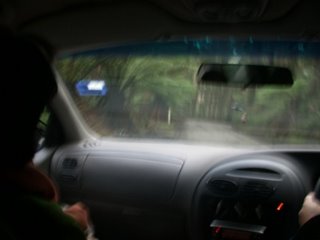


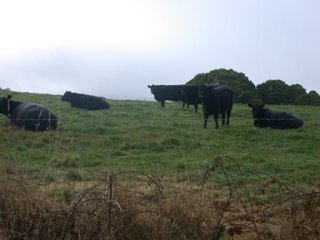




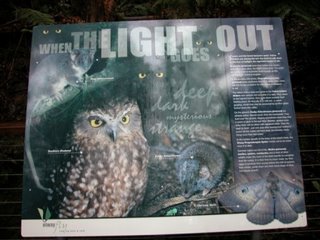

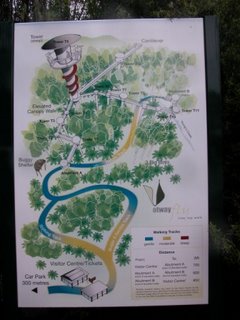





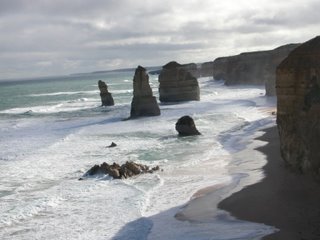
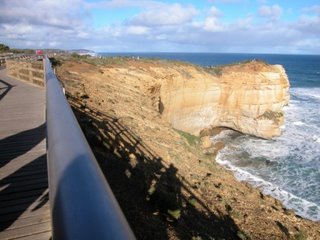


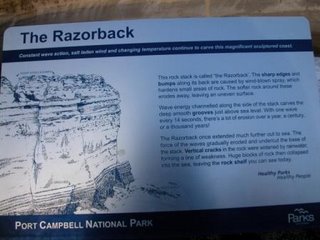


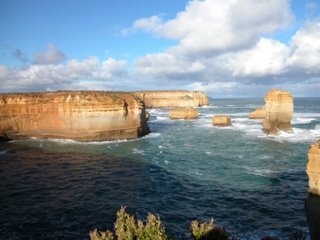


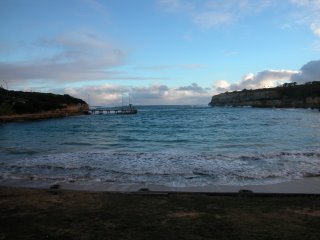


3 Comments:
Thanks, the temp was at max 13 celcius. Usually it is the srong wind that makes it colder. I suggest u pack enough warm clothing. bring along an umbrella or raincoat. The 3 days weather prediction was wet & rainy but we only got some drizzle during the day and heavy rain the first 2 nights. I hope u will have a good time.
That's it!!! The photos did it!!! I'm going down to OZ one of these days!!!
Yep, u r welcome and we can have a blog party over here.
Post a Comment
<< Home